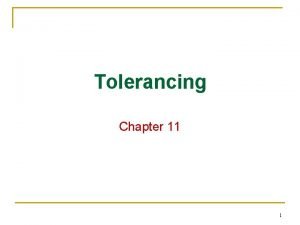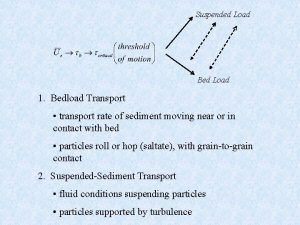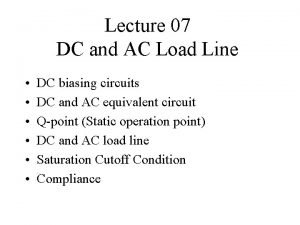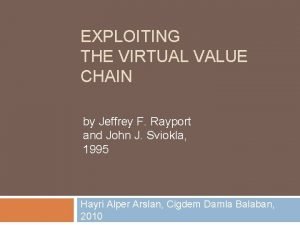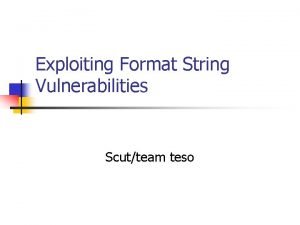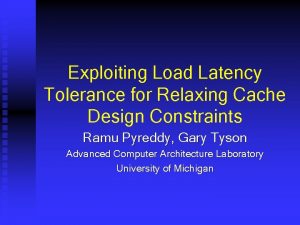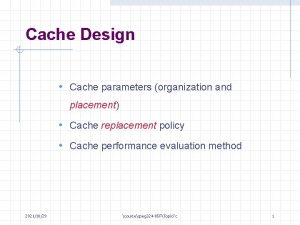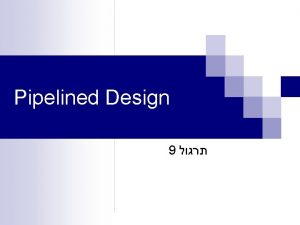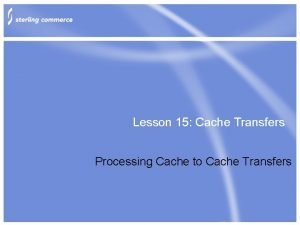Exploiting Load Latency Tolerance for Relaxing Cache Design


![Related Work n n Load Latency Tolerance [Srinivasan & Lebeck, MICRO 98] u All Related Work n n Load Latency Tolerance [Srinivasan & Lebeck, MICRO 98] u All](https://slidetodoc.com/presentation_image_h2/ed097688f7efd49e55eb5505a0a9fbed/image-3.jpg)
![Related Work(contd. ) n n Locality vs. Criticality [Srinivasan et. al. , ISCA 01] Related Work(contd. ) n n Locality vs. Criticality [Srinivasan et. al. , ISCA 01]](https://slidetodoc.com/presentation_image_h2/ed097688f7efd49e55eb5505a0a9fbed/image-4.jpg)







![Processor Configuration Similar to Alpha 21264 using Simple. Scalar-3. 0 [Austin, Burger 97] Fetch Processor Configuration Similar to Alpha 21264 using Simple. Scalar-3. 0 [Austin, Burger 97] Fetch](https://slidetodoc.com/presentation_image_h2/ed097688f7efd49e55eb5505a0a9fbed/image-12.jpg)






- Slides: 18

Exploiting Load Latency Tolerance for Relaxing Cache Design Constraints Ramu Pyreddy, Gary Tyson Advanced Computer Architecture Laboratory University of Michigan

Motivation Increasing Memory – Processor frequency Gap n Large Data Caches to hide Long Latencies n Larger caches – Longer Access Latencies [Mc. Farland 98] q Processor Cycle determines Cache Size q Intel Pentium III – 16 K DL 1 Cache, 3 cycle access q Intel Pentium 4 – 8 K DL 1 Cache, 2 cycle access n Need Large AND Fast Caches! n
![Related Work n n Load Latency Tolerance Srinivasan Lebeck MICRO 98 u All Related Work n n Load Latency Tolerance [Srinivasan & Lebeck, MICRO 98] u All](https://slidetodoc.com/presentation_image_h2/ed097688f7efd49e55eb5505a0a9fbed/image-3.jpg)
Related Work n n Load Latency Tolerance [Srinivasan & Lebeck, MICRO 98] u All Loads are NOT equal u Determining Criticality – Very Complex u Sophisticated Simulator with Rollback Non-Critical Buffer [Fisk & Bahar, ICCD 99] u Determining Criticality – Performance Degradation/Dependency Chains u Non-Critical Buffer – Victim Cache for noncritical loads u Small Performance Improvements (upto 4%)
![Related Workcontd n n Locality vs Criticality Srinivasan et al ISCA 01 Related Work(contd. ) n n Locality vs. Criticality [Srinivasan et. al. , ISCA 01]](https://slidetodoc.com/presentation_image_h2/ed097688f7efd49e55eb5505a0a9fbed/image-4.jpg)
Related Work(contd. ) n n Locality vs. Criticality [Srinivasan et. al. , ISCA 01] u Determining Criticality – Practical Heuristics u Potential for Improvement – 40% u Locality is better than Criticality Non-Vital Loads [Rakvic et. al. , HPCA 02] u Determining Criticality – Run-time Heuristics u Small and fast Vital cache for Vital Loads u 17% Performance Improvement

Load Latency Tolerance

Criticality – Effect of Load Latency on Performance n Two thresholds – Performance and Latency n A Very Direct Estimation of Criticality n Computation Intensive! n Static n

Determining Criticality- Latency Threshold = 8 cycles A Closer Look IPC Threshold=99. 6%

Most Frequently Executed Loads

Criticality(contd. . ) Benchmark (SPECINT 2000) # of Load Insns accounting for 80% of Load references BZIP 2 130 CRAFTY 905 EON 550 GAP 100 GCC 4650! GZIP 74 MCF 115 PARSER 305 TWOLF 185

Critical Cache Configuration

Effectiveness? n n n Load Reference Distribution u What %age of Loads Identified as Critical u Miss Rate for Critical Load References Critical Cache Configuration compared with u Faster Conventional Cache Configuration u DL 1/DL 2 Latencies – 3/10, 6/20, 9/30 cycles Critical Cache Configuration compared with u Larger Conventional Cache Configuration u DL 1 Sizes – 8 KB, 16 KB, 32 KB, 64 KB
![Processor Configuration Similar to Alpha 21264 using Simple Scalar3 0 Austin Burger 97 Fetch Processor Configuration Similar to Alpha 21264 using Simple. Scalar-3. 0 [Austin, Burger 97] Fetch](https://slidetodoc.com/presentation_image_h2/ed097688f7efd49e55eb5505a0a9fbed/image-12.jpg)
Processor Configuration Similar to Alpha 21264 using Simple. Scalar-3. 0 [Austin, Burger 97] Fetch Width 8 instructions per cycle Fetch Queue Size 64 Branch Predictor 2 Level, 4 K entry level 2 Branch Target Buffer 2 K entries, 8 way associative Issue Width 4 instructions per cycle Decode Width 4 instructions per cycle RUU Size 128 Load/Store Queue Size 32 Instruction Cache 64 KB, 2 -way, 64 byte lines L 2 Cache 1 MB, 2 -way, 128 byte lines Memory Latency 64 cycles

Results Benchmark # of Critical Load Insns. Refs (% of total Load Refs) Miss rate of Critical Loads for 1 K critical cache BZIP 2 23 18. 84 10. 6 CRAFTY 107 15. 87 28. 2 EON 52 16. 74 12. 7 GAP 26 13. 1 7. 1 GZIP 17 16. 2 12. 7 MCF 32 23. 86 13. 2 PARSER 33 18. 44 12. 8 TWOLF 42 14. 88 8. 6

Results Comparison with a faster conventional Cache Configuration IPCs normalized to 16 K-1 cycle Configuration 25 -66% of the Penalty due to a slower cache is eliminated

Results Comparison with a faster Conventional Cache Configuration IPCs normalized to 32 K 1 cycle Configuration 25 -70% of the Penalty due to a slower cache is eliminated

Results Comparison with a larger Conventional cache Configuration IPCs normalized to 16 K-3 cycle Configuration

Results Comparison with a larger Conventional cache Configuration IPCs normalized to 32 k_6 cycle Configuration Critical cache Configuration outperforms a larger conventional cache

Conclusions & Future Work n n Conclusions u Compares well with a faster conventional cache u Outperforms a larger conventional cache in most cases Future Work u More heuristics to refine “criticality” u Why are “critical loads” critical? u Criticality of a memory address vs. criticality of a load instruction u Criticality for lowpower Caches
 40h6 tolerance
40h6 tolerance Central tolerance and peripheral tolerance
Central tolerance and peripheral tolerance Thrust load bearing
Thrust load bearing Red dot
Red dot Pux
Pux Dc and ac load line
Dc and ac load line The virtual value chain
The virtual value chain Define new entry in entrepreneurship
Define new entry in entrepreneurship Pure-ftpd exploit
Pure-ftpd exploit Large and fast: exploiting memory hierarchy
Large and fast: exploiting memory hierarchy Algorithms for recovery and isolation exploiting semantics
Algorithms for recovery and isolation exploiting semantics Exploiting machine learning to subvert your spam filter
Exploiting machine learning to subvert your spam filter Exploiting the sponsorship examples
Exploiting the sponsorship examples Topic sentence about university
Topic sentence about university Noise comparative and superlative
Noise comparative and superlative Olive oil relaxer timing chart
Olive oil relaxer timing chart Reasoning judgement decision making relaxing
Reasoning judgement decision making relaxing Thioglycolic acid cosmetology
Thioglycolic acid cosmetology Lricalculator
Lricalculator
